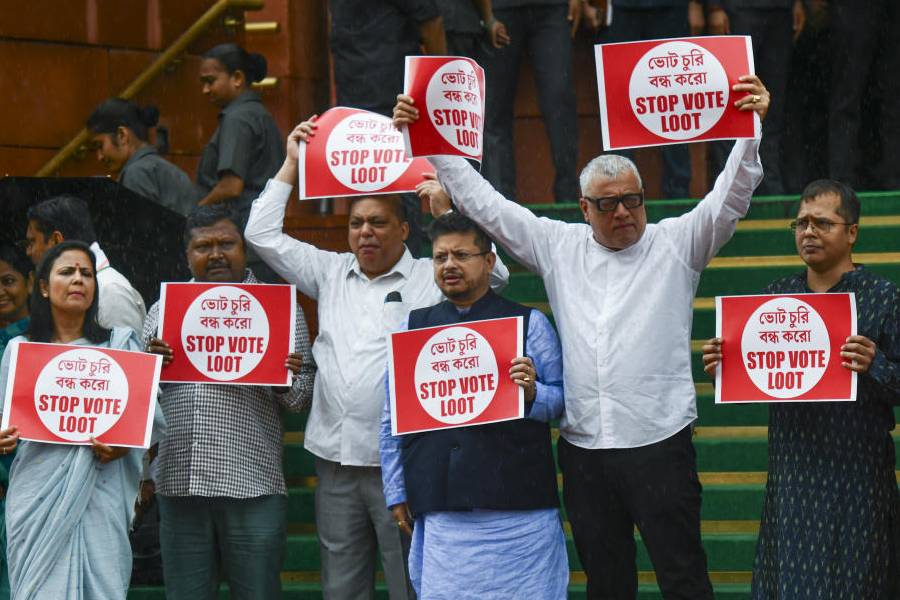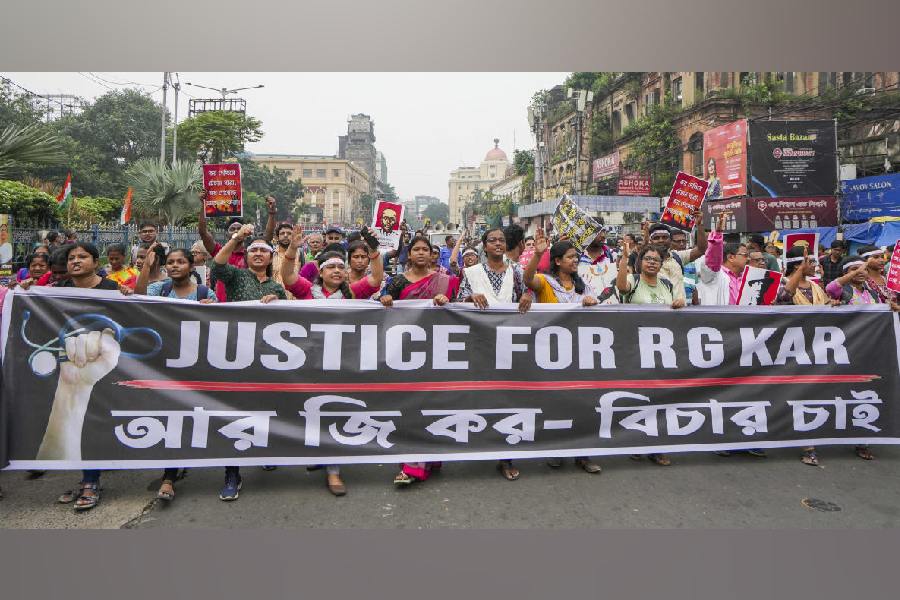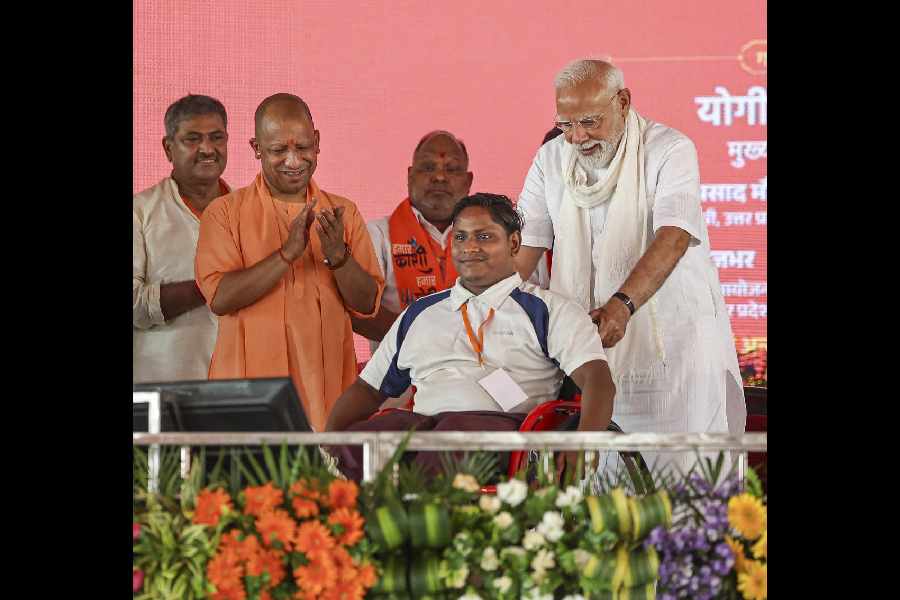 |
| WORK IN PROGRESS: C. Shikha, district collector of Dharwad, Karnataka, merged the jobs scheme with adult literacy and educating women workers on malnutrition, pregnancy, anaemia and childcare |
Vandana Yadav had no time to revel in the beauty of the tea gardens that surrounded her sprawling bungalow. After all, hunger was stalking Jalpaiguri in northern Bengal. The tea industry — the mainstay of the economy there — was going through a severe crisis. Over a dozen gardens had closed. Laid off workers and their families — totalling over 81,000 people — were starving.
It was a Catch-22 situation: the owner couldn’t run the gardens unless the workforce was cut drastically, but the labourers had no other means of livelihood. So Yadav, the 39-year-old district collector (DC), hit upon an idea. She put into effect a scheme initiated by the government under the Mahatma Gandhi National Rural Employment Guarantee Act (MGNREGA) — which ensures at least 100 days of work in a year — to engage the workers as well as revive the ailing gardens.
That was three years ago. Today, barring one, all Jalpaiguri gardens have reopened. “It was a simple formula. We’d offer the workers’ families 100 days of work and tea garden employers would have to employ them for 200 days, on the condition that they wouldn’t retrench a single labourer,” Yadav recalls.
Six years after the MGNREGA got the President’s nod on September 5, 2005, Yadav has been demonstrating how the act — maligned in many quarters as a money drainer — can bring about change. And she isn’t the only DC — who run the show as district programme co-ordinators under the MGNREGA — to do so. Across the country some young IAS officers are experimenting with the scheme to ensure that it does more than generate employment in rural India.
“These collectors have shown how a little out-of-the-box thinking can work wonders with this unique social scheme,” says D.K. Jain, joint secretary (MGNREGA), ministry of rural development (MoRD). He points out that a proactive district collector can mobilise the system by motivating district officials, gram panchayats, politicians, civil society organisations as well as the community to deliver. “The DCs are the fulcrum of administration. If they work well, everything falls in line.”
How the scheme can be tweaked for a community ravaged by ethnic hostilities was best demonstrated by 31-year-old Jacintha Lazarus, the DC of Churachandpur in Manipur. This district, sharing a border with Myanmar, was hit by insurgency and ethnic strife between two warring tribes — the Paithes and Kukis. About 50 villages had been destroyed since the groups started clashing violently in 1997. The region had also been troubled by the presence of 13 underground secessionist groups.
 |
 |
| DYNAMIC DCs: Krishan Kumar (top), district collector of Kandhamal, Orissa, used the jobs law to create communal harmony. He involved the panchayats, village leaders and NGOs to build roads, ponds and irrigation wells so that agriculture could be resumed. Vandana Yadav (below), district collector of Jalpaiguri, offered tea garden workers’ families 100 days of work; tea garden employers would have to employ them for 200 days, on the condition that they wouldn’t retrench a single labourer. |
Lazarus used MGNREGA to bring the hostile chiefs of 64 villages to the negotiating table and make them work together to build roads and watershed projects and rejuvenate the environment. “The reason for taking up the project was community mobilisation and to revive a catchment area which houses over 2 lakh people,” says Lazarus. “Eventually the tribes shook off their mutual mistrust and joined hands to plant rubber and fruit saplings in some areas.”
As the land belongs to village chiefs in this region, she got them to sign an agreement with the government to assure them that the government was not out to “grab” their land. After several meetings she was even able to convince the secessionists that the administration’s motive was the public good.
“She’s done a commendable job and is getting tremendous support from the community, including disenchanted youths,” says Hemnath Rao, director, Centre for Poverty Studies and Rural Development at the Administrative Staff College of India (ASCI), Hyderabad.
“If someone has been able to mobilise people in such a hostile environment, the scheme can work anywhere,” says Rao, who visited Churachandpur to review the project for the MoRD.
Krishan Kumar, a 35-year-old doctor-turned-civil servant, used the act to generate work — and heal communal scars. The DC of Kandhamal in Orissa utilised the scheme in a region wracked by communal riots that left 38 people dead and thousands of houses burnt along with churches three years ago.
When he took charge, there was a gulf between the mostly Hindu Kandha tribe and the Christian-converted Pano Dalits. “My immediate goal was to offer them some livelihood and help them rebuild the assets damaged in the riots,” he says.
The scheme turned out to be an ideal welfare programme. “We involved all the stakeholders — the panchayats, village leaders and non-government organisations — to create harmony between the hostile groups and build roads, ponds and irrigation wells so that agriculture could be resumed,” says Kumar. It worked — countering even Naxalites who failed to extend their influence in the area, though they were active in the neighbouring districts.
Sushil Kumar Lohani, director (special projects) of Orissa’s panchayati raj department, stresses that over 56 per cent of eligible families have been covered by the MGNREGA. “That’s far above the national average of 23 per cent. And the way the district managed natural resources is now serving as a benchmark for other districts.”
Indeed, the DCs’ successful attempts are being tried out elsewhere. Yadav’s model is being replicated by the central government to revive ailing tea gardens in the Northeast. In the Jaipaiguri gardens, the MGNREGA workers refurbish the drainage and irrigation and level the land to keep the dilapidated gardens going even when not in use. This, in turn, helps the owners to focus on modernisation and replace ageing tea bushes.
“After experimenting with the first garden in Chinchula, it appeared to be a win-win situation. Eventually it became a model for other closed gardens as we systematised this with guidelines involving self-help groups and regular accounting,” says Yadav.
Ashwani Kumar, a professor at the Tata Institute of Social Sciences in Mumbai and member of the Central Employment Guarantee Council under the rural development ministry, stresses that schemes have to be adapted to counter specific problems in other areas. “There are many micro-Indias in India. What works in Delhi may not work in remote Jalpaiguri.”
Kandhamal’s success, he adds, lies in the creation of “social capital” in a conflict-ridden society. “You can’t work alone; you need to build a team and motivate it from the top,” stresses Krishan Kumar.
People’s empowerment is the underlying theme of the MGNREGA, says social activist Nikhil Dey, who has closely studied the scheme’s implementation across the country. “Since the beneficiaries are directly involved and the scheme is so designed that power is decentralised, people are free to raise objections and demand their rights.” Ashwani Kumar suggests that all existing government welfare schemes be aligned or converged with MGNREGA for minimising pilferage and ensuring delivery.
When it comes to convergence of schemes, C. Shikha of Karnataka’s Dharwad is perhaps far ahead of other DCs in her league. “Since so many rural workers were coming under one umbrella to work, we thought this would be an ideal place to implement other projects and educate villagers about health, banking, insurance and literacy,” says the 34-year old engineer-turned-bureaucrat.
 |
| TASK FORCE: Road construction in Churachandpur, Manipur |
Since migration is rampant in the region, her first challenge was to convince villagers to stay back and work under MGNREGA. After basic works such as road and bund construction, plantation work, lake de-silting and social forestry got going, she started merging the scheme with other activities such as adult literacy. The Centre’s adult literacy scheme in the state had ended in 2008, rendering 700 village-level educators jobless. “We decided to take them on board the MGNREGA,” says Shikha. They teach workers for two hours every day.
The project has also been converged with health education. “We began educating women, who constitute 45 per cent of the workers, on malnutrition, pregnancy, anaemia and childcare,” she says. But Nutrition Garden is the scheme she’s most proud of. “Rural women usually don’t eat nutritious food. The idea is to make a kitchen garden in every home where the family can grow its own fruits and vegetables.”
Of course, the DCs’ work is by no means a bed of roses. Problems arise especially when payments get delayed. “Although there is a mandate to pay wages within a fortnight, I have seen workers waiting for wages for several months even in districts with pro-active DCs,” says Ashwani Kumar. But MoRD’s Jain believes the issue will be resolved. “We are in the process of fixing the chinks in the armour. We are working on new models of fund disbursement through banks and post offices that can speed up payments.”
The attitude of officials at lower levels is another problem. Some experts say muster roll frauds and poor record keeping are rampant even in the best performing districts. “The mismanagement can often be traced to apathetic babus who have lost the energy to govern. These people are sitting in the way of young officers,” says Rao of ASCI. Corrupt officials resent the fact that the scheme has little room for pilferage. “Unlike other government schemes, only 6 per cent is earmarked for administrative cost (salary, infrastructure building and so on). Most of the Rs 45,000 crore is meant to reach the poor,” explains Dey.
But the MGNREGA is bringing in change, Jain holds. “For instance, in Andhra Pradesh the MGNREGA culture has permeated so deeply that people have become aware of their rights and are demanding things from the system.” DCs, in short, are being forced to become pro-active.
Ashwani Kumar believes the biggest success of the MGNREGA is that it has given a voice to the poor. “This will help consolidate the ‘last mile democracy’ in India — give power back to the common man with even the poorest villager participating in governance,” he says. With help from a handful of bureaucrats, a revolution is rolling in.











